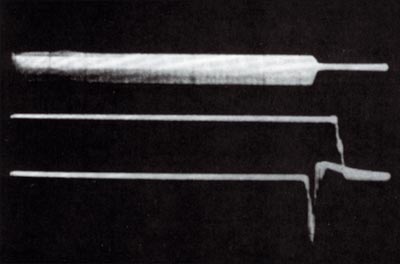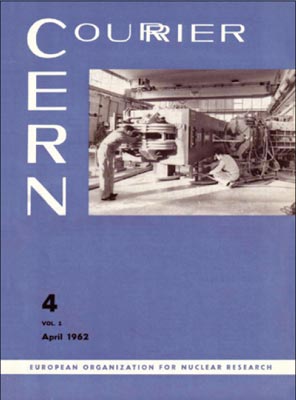A selection of highlights from the past 50 years.
Beam in four months

The most important event that has yet happened at CERN is the subject of the press release issued on 25 November. This news, which came just as the first proofs of this issue were coming off the press, was important enough to warrant rearranging the lay-out.
On July 27th the 100 units forming the magnet of the proton synchrotron were energized for the first time … On 13 October, after the radio frequency accelerating system had come into operation, events moved fast. On the 15th, an accelerated beam was observed during a few milliseconds. On 22 October the energy reached 400 MeV.
It was 7.40 p.m. on 24 November when the beam was accelerated to approximately 24 GeV, twenty-four thousand million electronvolt, i.e. the maximum energy under normal operating conditions. The acceleration was steady; moreover, 90% of the proton beam trapped by the synchrotron reached maximum energy. According to the physicists, this proportion is surprisingly high.
On the morning of 25 November all of the members of the Proton Synchrotron Division gathered in the main auditorium. John B Adams, under whose leadership CERN’s gigantic project has been successfully carried out, gave an account of the operations of the last few days. Expressing his gratitude to all those who, at CERN, had played a part in constructing and bringing the accelerator into operation, he announced: “Nuclear physicists will soon be able to use the machine.”
Next, Professor C J Bakker, director-general of CERN, said: “Of course, such a machine could only be the result of team work. But the team could not have worked at full pitch without the impetus of a leader: this leadership was provided by J B Adams. It is with the greatest of pleasure that I convey to him and his division the warmest congratulations of the president of the Council.”
• November 1959 pp1, 6–7 (extract)
Quarks and aces come to CERN
In February, a number of events combined to provide the kind of excitement for the physicists that more than makes up for the long periods of monotony and to make the rest of the staff somewhat more aware than usual that interesting things were happening.
The clues to part of the excitement had, in fact, been available in the library for a week or two, in the form of “preprints” of two theoretical papers, one by M Gell-Mann, of the California Institute of Technology, US, and the other by G Zweig, of the same Institute but at present a visiting scientist at CERN. Gell-Mann’s paper was published in Physics Letters on 1 February; Zweig’s, the more detailed of the two, is expected to appear later in Physical Review. Produced independently, both papers put forward a possible new way of looking at the theory of “unitary symmetry” known as SU3…
…The new ideas had a basic simplicity that was very appealing, and difficulties that had to be explained away in the former versions of the theory did not seem to arise this time, yet the idea of fractionally charged particles seemed quite preposterous. Even those who had suggested it seemed to share the doubts; Gell-Mann called his new particles “quarks”, bringing together literature and science with a reference to Finnegans Wake! Zweig turned to the field of card games for inspiration, and called his particles “aces”, with their combinations “deuces” and “treys”.
• March 1964 pp26–27 (extract).
Inauguration of the PS
Prof. J Robert Oppenheimer, director, Institute for Advanced Study, Princeton, speaking on behalf of the American Physical Society and of the National Academy of Sciences: “We wish you a future of new discovery, of increased understanding of nature, as a bright example of that co-operation which is required of us, for our survival and for the flourishing of high culture.
…We salute the vision and devotion of those who have made possible the proton synchrotron. We recognize not only that it marks a technical achievement of high significance, but also that it is a symbol of the common enterprise of people from many nations to give to all mankind new understanding of the forces that shape our physical environment.
…May those that work at CERN in the years to come find there, in steadily growing knowledge of the wondrous order of nature and of nature’s laws, ever renewed challenge for the questing mind and ever deepening satisfaction for the questing spirit.”
• March 1960 pp6–12 (extract).
The first g-2 experiment

The issue for April 1962 featured the g-2 experiment, with a photo of the 6 m magnet appearing on the cover. The magnet was the heart of the first g-2 experiment, the aim of which was to measure accurately the anomalous magnetic moment, or g-factor, of the muon. This experiment was one of CERN’s outstanding contributions to physics and for many years was unique to the laboratory. Indeed, three generations of the experiment were performed at CERN during its first 25 years.







